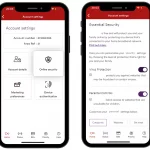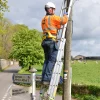Advertising Watchdog Seeks Clearer ISP Promotions of Broadband Speed
The Advertising Standards Authority has today called for a change to the way that broadband speeds are advertised by Internet Service Providers (ISP) in the United Kingdom, which reflects the results of a new study that found “most consumers” wrongfully expected to get the speed advertised in their ISPs headline claim.
At present the existing guidance requires ISPs to promote a headline speed that is achievable by at least 10% of their customers (i.e. the fastest 10%), which must also be preceded by an “up to” qualifier and a “prominent disclaimer” of any aspects that could impact your service performance.
Advertisement
On top of that most fixed-line broadband subscribers, particularly those who take a traditional DSL (ADSL or VDSL2 / FTTC) based fixed line product, will also give new customers a personalised estimate of their expected broadband speed during the sign-up process (this usually comes in the form of an upper and lower performance range).
Since the introduction of the original changes, complaints to the ASA regarding speed claims have fallen by 60%. However earlier this year the Government’s former Digital Economy Minister, Ed Vaizey MP, joined with many other MPs and related groups in order to call for the current approach to be improved (here, here, here and here).
Ed Vaizey MP said (March 2016):
“I hope that the Advertising Standards Authority will crack down on how providers advertise their speeds. At the moment, if only 10% of customers are receiving the advertised speed, in the eyes of the ASA that is supposed to be okay.
I totally accept that the ASA does a good job – it is a great example of self-regulation – but it really needs to go further on that. In my humble opinion, at least 75% of people should be getting the speeds that the broadband providers are advertising.”
In May 2016 the ASA bowed to Government concern and announced that they would conduct some new consumer research in order to examine whether the broadband speed claims made by ISPs are fair.
Today the results have been published and it looks as if broadband ISPs could soon be forced to accept even stricter rules, although the Committee of Advertising Practice (CAP) will first have to conduct a new review in order to define the best way forward.
Advertisement
Guy Parker, ASA Chief Executive, said:
“Making sure ads don’t mislead is at the heart of what we do. We’ve taken action this year to tackle confusing broadband pricing, to the benefit of consumers. Our new research indicates that speed claims in ads contribute to consumers’ expectations of the broadband speeds they’ll receive, but their expectations are not being met. That needs to change.”
Shahriar Coupal, Director of CAP, said:
“CAP welcomes the ASA’s research and we’ll now begin the process of updating our guidance and publish a response next spring.
The research provides good insights into consumers’ understanding of broadband speed claims, but it doesn’t identify an obvious alternative way to communicate speeds that would be suitable to everybody’s needs. It also tells us that consumers believe that advertising can only do so much, which underpins the importance of detailed broadband speed information being provided elsewhere.”
The GfK research itself claims to have used a qualitative method, which involved a tiny sample of just 14 mini-groups of 6 participants, each lasting 2 hours, and 12 individual depth interviews each lasting 1 hour. The study also tested consumers’ understanding of alternative speed claims including average speed claims, range speed claims and minimum speed claims.
GfK Results
· Speed is an important factor for a significant proportion of consumers who are making decisions between providers
· Levels of knowledge and understanding of broadband speeds vary, but it is low overall with many not knowing what speed they need to carry out daily online tasks
· Most understand that the higher the number in the ad, the higher the speed of the service, but many are unclear on what this means for them and what speed they would likely achieve
· Crucially, the research shows that despite that uncertainty most consumers believe they are likely to receive a speed at or close to the headline speed claim when, for many, that is not likely to be the case
The actual results aren’t easy to summarise and we are concerned about the small sample size, as well as the fact that much of the study appears to focus on the headline speeds and largely overlooks the personalised estimates that ISPs are supposed to give their new subscribers. Upload speeds also don’t get a mention, even though many have called for them to be included.
However perhaps the most interesting bit of the research stems from where the ASA proposed several alternative approaches to advertising broadband speed. It’s worth reading this quick summary of the responses in order to get an idea of the ASA’s position, as well as that of those they surveyed.
Alternative speed claims
1. Change the existing ‘up to’ claim to be applicable to at least 25% or 50% of customers.
Whilst participants agreed that it was more useful to know the speed that at least 25% or 50% of customers could achieve when compared to 10% of customers, views were still largely negative. Participants reflected that even at 50%, the speed claim was not relevant to a majority of customers which meant that it was still difficult to gauge the type of speed they might expect to achieve.
2. Using an average speed claim (e.g. “Average speed of 10Mbps”).
Overall, average speed claims received mixed responses. Some participants were positive towards this type of claim as they felt it gave an indication of the speed that most customers would receive. Especially when compared to up to speed claims, some felt that an average provided a figure that more people were likely to achieve.
These participants tended to interpret average speed claims as ‘50% of customers will achieve above the average’.
3. Using a range in speed claims (e.g. “Typical speeds of 3-13Mbps”).
Views regarding range speed claims were also mixed across the research. Range information was particularly useful for those who felt that they could best determine the speed they would achieve by knowing what the majority of customers would achieve. Most participants felt optimistic that they would fall within the typical range. They felt that this would help manage their expectations.
Those with more knowledge regarding factors that could impact on speeds achieved had mixed views towards range claims. Some anticipated that they would use this knowledge to help them determine where within the range they would be likely to fall. However others felt that the range information was too broad and based on their experience knew that there were factors that would impact on speed achieved, but were unsure what this meant for where within the range they would fall.
NOTE: The range itself was apparently based on typical speeds that could be achieved by 80% of customers and people appeared to favour adverts that included a reference to the 80% clarification (i.e. “80% of customers achieve download speeds that fall within this range”).
4. Using a minimum speed claim (e.g. “Minimum speed of 60Mbps”).
Many research participants found the minimum speed claim useful and appealing. For many the appeal focused on the simplicity and transparency of the speed claim. Participants anticipated that customers would never achieve a speed below the speed specified and for that reason felt that the claim constituted a ‘guarantee’. This was appealing in itself, especially amongst those who were more sceptical regarding claims made in advertising.
A few more knowledgeable participants further noted that although a minimum speed was transparent, it was not attractive as for some services (e.g. ADSL), the speed advertising would look very low. These participants queried whether they would even pay attention to an advert presenting a very low speed and concluded that they would be unlikely to look into the advertised product as it lacked appeal.
The ASA seems to have considered the unusual option of a “minimum speed” above, which in our view is a bit bonkers unless a stricter definition is adopted. Otherwise the only set figure that an ISP could provide for this is close to ZERO (Mbps) and that would have a hugely negative impact on VDSL2 (FTTC) and ADSL2 based providers (a small number of lines can drop below 1-2Mbps). On this point we’d encourage the ASA to consult ISPs about the technical reality of such service provision.
Advertisement
Otherwise it looks like the ‘range‘ and ‘average speed‘ options drew more favour from respondents, albeit somewhat depending upon how that information was reflected (i.e. people clearly liked to be informed about what the range itself represented, such as whether it applied to 80% of customers).
It’s also worth remembering that service speeds can fluctuate due to all sorts of reasons, such as traffic management policies, long copper lines, peak time network congestion and sometimes even issues like slow WiFi or poor home wiring, many of which represent aspects that ISPs cannot control.
In that sense there’s always going to be some degree of confusion or performance variation, no matter which approach is adopted. We suspect that when the mass media starts reporting on this a lot of what they write may also overlook the personalised estimates that subscribers are supposed to receive.
James Blessing, Chair of the ISPA Council, said:
“The broadband market has changed dramatically in recent years and the Internet Industry fully supports the ASA’s move to bring the guidance on broadband advertising up to date. The ASA now needs to adopt an evidence-based approach to developing a revised set of rules that delivers actual benefits to consumers and takes account of developing broadband technologies.
Any new guidance needs to reflect that whilst speed is an important factor, it is not the only reason a customer decides on a deal. Crucially, the ASA’s research has not identified an effective alternative for the current approach to “up to” speed claims and ISPA, alongside the wider internet industry, looks forward to supporting the ASA in developing a revised and evidence-based guidance on this and getting a workable new understanding of how speeds should be advertised.”
Tom Mockridge, Virgin Media CEO, said:
“This is long overdue reform of a loophole which lets companies advertise a headline broadband speed if it is available to only 10% of customers.
Consumers should know what they’re paying for and not be hoodwinked by a little known rule which is supposed to be in their interest.”
It’s worth pointing out that Virgin Media also commissioned Ipsos MORI to research consumer attitudes to the 10 per cent rule, which found that three-quarters of consumers felt misled when speed and usage claims are not included in adverts (rising to 82% among older people aged 55-75) and nine-out-of-ten believe this information is important in broadband advertising.
The onus for finding the best balance now rests firmly with the Committee of Advertising Practice (CAP), which will report back during Spring 2017 with their proposals. No doubt whatever it proposes will end up being divisive, with even the research showing that there was no single solution where everybody could reach 100% agreement.
If an average speed is adopted then we might see standard FTTC packages being offered as something around 25-30Mbps (instead of ‘up to’ 38Mbps today), while ADSL2+ services would drop from ‘up to’ 17Mbps to around 6-8Mbps. On the other hand this would benefit Virgin Media and pure fibre optic (FTTP/H) providers, where advertised speeds are usually more reliable.
Mark is a professional technology writer, IT consultant and computer engineer from Dorset (England), he also founded ISPreview in 1999 and enjoys analysing the latest telecoms and broadband developments. Find me on X (Twitter), Mastodon, Facebook, BlueSky, Threads.net and Linkedin.
« IPAct – Controversial New UK ISP Internet Snooping Bill Becoming LAW


















































Comments are closed